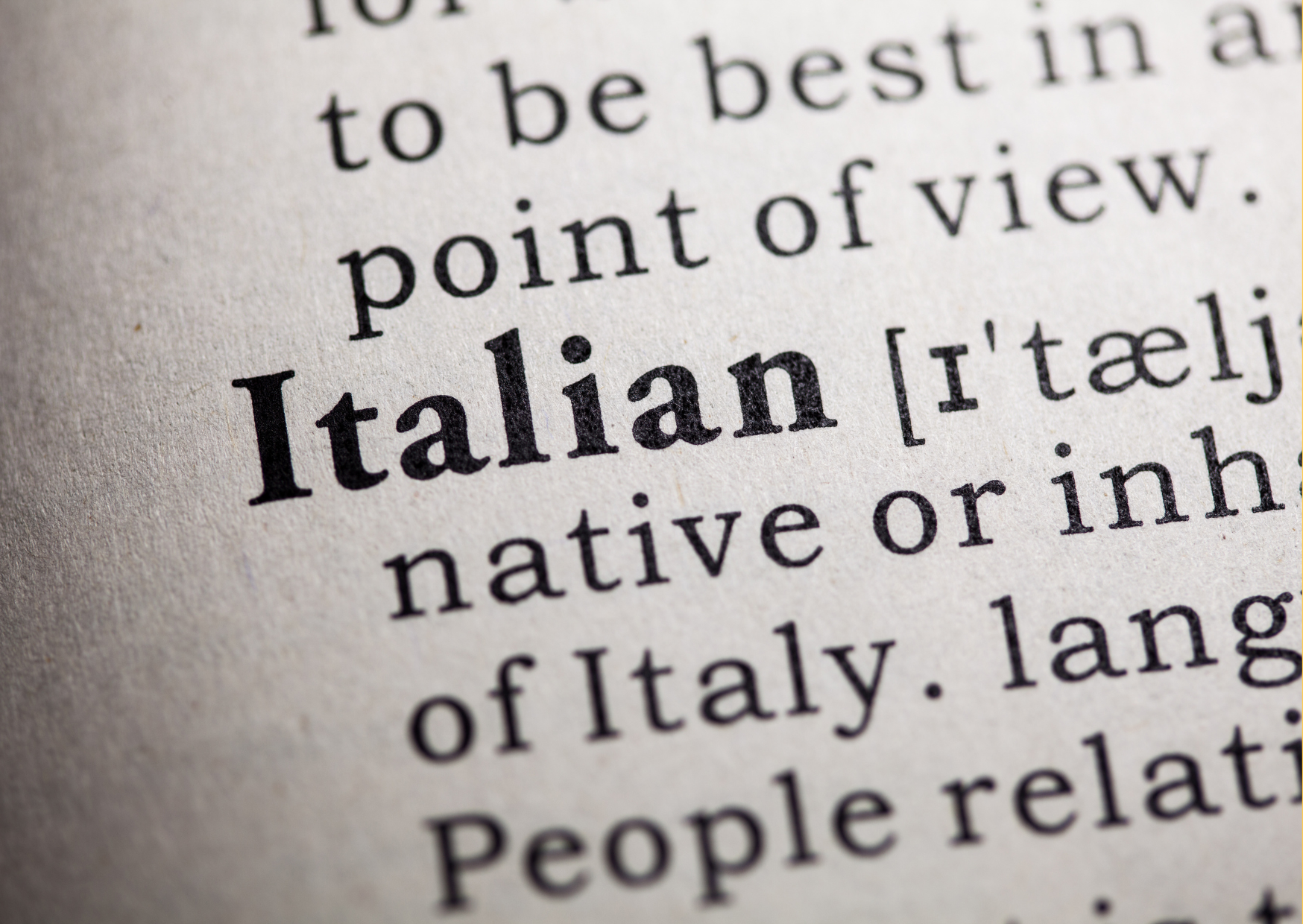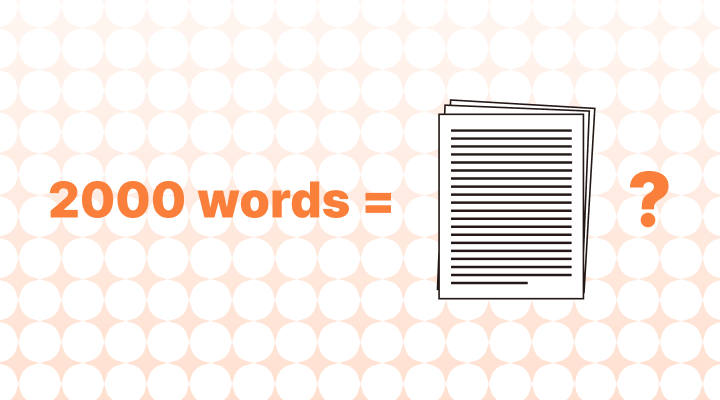The length of a 2,000-word essay can greatly differ from language to language. Keep reading to find out how many pages a 2,000-word essay is in different languages around the world.
- English
- Chinese (Mandarin/Standard Chinese)
- Spanish
- Hindi
- French
- Arabic (Modern Standard Arabic)
- Russian
- Portuguese
- Indonesian
- Japanese
- German
- Italian
- Korean
- Tagalog
English
- Font: Times New Roman
- Font size: 12
- Line spacing: Double spacing
2,000 words in English is about 8 double-spaced (4 single-spaced) pages. English is one of the many languages that prefer word count over character count.
Times New Roman is the most standard font for essays in English with size 12 being a widely accepted font size. Many American universities prefer double spacing for college-level papers. The font Times New Roman was commissioned and popularized by the Times, a British newspaper. The font even became popular for academic papers in other languages that use the Latin alphabet as you will see later in this article.

Chinese (Mandarin/Standard Chinese)
- Font: SimSun
- Font size: 12
- Line spacing: Single spacing
There are no spaces in Chinese, so splitting sentences into a finite number of words can be inconsistent across different people. Different individuals can have different interpretations of how to divide Chinese sentences into words. It is especially ambiguous for characters like 了 (le) or 儿 (er), which typically supplement other characters and words, because some may argue they are their own separate word while others may claim that they should be included with other stand-alone words.
If there are roughly 1.7 characters per word in Chinese, 2,000 words would be around 3,600 characters. 3,600 characters is about 2.5 pages, so that means 2,000 Chinese words is roughly 2.5 single-spaced pages. However, note that it is much more commonly accepted to use character count instead of word count for Chinese because the language does not use spaces.
SimSun is the Times New Roman of Chinese. Most Chinese professors will prefer font size 10 or 12, so we went with font size 12 along with single spacing, a commonly accepted line spacing for Chinese.
Spanish
- Font: Times New Roman
- Font size: 12
- Line spacing: Double spacing
Like English, Spanish uses the Latin alphabet along with spaces between words, so it is easy to get a word count. 2,000 words in Spanish is approximately 6.5 double-spaced pages, which is shorter than English’s 8 double-spaced pages. A reason for this may be that Spanish uses more articles (el, la, los, las, lo, etc.) than English. These shorter words cause Spanish to need fewer pages to reach 2,000 words. In other words, Spanish will typically have more words per page than English.
Although different Spanish university professors have different preferences, Times New Roman, font size 12, and double spacing are standard formatting choices for the Spanish language.
Hindi
- Font: Kruti Dev
- Font size: 12
- Line spacing: 1.5 spacing
2,000 words in Hindi is about 5 pages with 1.5 spacing in the font Kruti Dev and in font size 12. Kruti Dev is a standard font for Hindi and is used in official government documents and other formal paperwork.
Even though Hindi is spoken by millions in India, it is common for Indian university professors to require their students to write essays in English, as English is one of the official languages of India. There are thousands of different Indian languages, so in many cases, college courses are taught entirely in English, which is a common ground for students from different regions of India. If you are studying abroad at an Indian university, you will most likely be writing essays in English (unless you are taking a Hindi or Marathi language class). However, nowadays, Indian universities are encouraged to teach classes not just in English but also in regional languages. This is because Indian students who were not fluent in English would tend to struggle and even drop out of Indian universities, which usually only taught classes in English.
French
- Font: Times New Roman
- Font size: 12
- Line spacing: Double spacing
Similar to English and Spanish, 2,000 words in French is about 7.5 pages double-spaced in the font Times New Roman with font size 12. Like Spanish, French requires more articles than English, causing it to require fewer pages to reach 2,000 words because of these shorter articles.
For example, sentences like “He likes milk.” would become “Il aime le lait.” in French. “Milk,” in this context, would not require an article in front of it in English. However, in French, “milk” would need the article “le” (the) preceding it. When comparing these sentences in English and French, you can see the French sentence needs this extra short article, much like Spanish.
Arabic (Modern Standard Arabic)
- Font: Simplified Arabic
- Font size: 14
- Line spacing: Double spacing
In Arabic, 2,000 words equate to roughly 6.5 pages double-spaced in the font Simplified Arabic and font size 14. The key difference between Arabic and languages that use the Latin alphabet like English is that Arabic is written horizontally from right to left. This can feel counterintuitive for native English speakers. Even native Chinese and Japanese speakers, who may write from right to left when writing vertically, may find this jarring (because they still write from left to right when writing horizontally). Much of modern software, however, is optimized for left to right languages, so native speakers of Arabic may find that they have to adapt themselves to an inconvenient interface when set to their mother tongue.
Although font size 12 may be an industry standard for many other languages, font size 12 for Arabic can look small, making it difficult to read, especially for non-native speakers of Arabic. Hence, it is recommended to use a larger font to increase readability. Arabic characters can look smaller than Latin letters because the bodies of Arabic letters are small even if any extended parts of the letters are just as long as Roman letters. Notice the difference between ط and b. The smaller body (the circular part) makes the character look smaller overall. Other more obvious examples would be و and ه compared to g and o.

Russian
- Font: Times New Roman
- Font size: 14
- Line spacing: 1.5 spacing
2,000 words in Russia is approximately 9 pages with 1.5 spacing. Times New Roman and font size 14 are widely accepted for academic papers.
The Cyrillic script of Russian, like Arabic, tends to look smaller than English at the same font size. Therefore, instructors may require font size 14 instead of 12 because Russian needs a larger font to be more easily read. For example, take the lowercase Russian character н and compare it to the lowercase Latin letters h and p. Both Latin letters are vertically longer than the Russian н. Lowercase Russian letters tend to not use up as much vertical space compared to lowercase Latin letters, which is why Russian text may look smaller at the same font size.
Portuguese
- Font: Times New Roman
- Font size: 12
- Line spacing: 1.5 spacing
As with English and Spanish, Times New Roman is a popular font for academic writing in Portuguese. 2,000 words in Portuguese is about 6 pages with 1.5 spacing in font size 12. Similar to other Romance languages like Spanish and French, Portuguese has more articles than English. These articles, which are short in length, may be why Portuguese does not need as many pages to reach 2,000 words compared to English.
Although grammatically similar to Spanish, Portuguese uses definite and indefinite articles differently than its linguistic cousin. The differences between the two languages are interesting, especially because some native Spanish and Portuguese speakers can understand each other. Both languages, however, have many variants depending on the region, especially because both previously had colonies around the world.
Indonesian
- Font: Times New Roman
- Font size: 12
- Line spacing: 1.5 spacing
2,000 Indonesian words is around 5.5 pages in 1.5 spacing. Similar to English papers, university-level Indonesian essays are typically in Times New Roman and font size 12.
Indonesia, although an Asian language, uses the Latin alphabet like English and the Romance languages. The country was a Dutch colony for over 100 years, and when the Dutch introduced the Latin alphabet to Indonesia, more Indonesians began to learn to read and write. Previously, many Indonesian locals, especially outside the cities, were illiterate, and the nation had hundreds of different languages, some with writing systems and some without. The introduction of the Latin alphabet encouraged the creation of a standardized writing system, boosting Indonesia’s development.
Japanese
- Font: MS Mincho
- Font size: 10
- Line spacing: Single spacing
Like Chinese, there are no spaces between words in Japanese, and it is much more common to use character count instead of word count for Japanese as well. An average Japanese is roughly 2 characters in length. That means 2,000 words will be about 4,000 characters in Japanese. 4,000 characters is about 2 pages, so that means 2,000 words in Japanese would amount to around 2 pages single-spaced in the font Mincho and in font size 10.
The standard font size for Japanese papers at the university level is 10, the smallest font size of all the languages we covered. The single spacing also makes the page count small in comparison to other languages. East Asian languages tend to prefer smaller fonts and single spacing compared to their western counterparts.
German
- Font: Times New Roman
- Font size: 12
- Line spacing: 1.5 spacing
In German, 2,000 words would roughly amount to 5.5 pages with 1.5 spacing in Times New Roman and font size 12. For academic writing in German, 1.5 spacing is strongly preferred over double spacing as double spacing is generally only used for drafts that are to be proofread. German, like the Romance languages, uses more articles than English. A 2,000-word essay in German that was double-spaced would be around 7 pages, which is fewer pages than an English essay of 2,000 words.
Among its articles, German has three genders (masculine, feminine, and neutral), which can make learning German especially difficult for non-native speakers. Although these articles may come naturally to local Germans, who are exposed to them from a young age, non-native speakers can struggle to remember the genders associated with different nouns.

Italian
- Font: Times New Roman
- Font size: 12
- Line spacing: 1.5 spacing
2,000 words in Italian is approximately 5 pages with 1.5 spacing. Like German, Italian academic papers are typically written with 1.5 spacing in Times New Roman and font size 12.
Italian is one of the languages sprinkled throughout our daily lives; we can find Italian words around us every day. Not only is Italian cuisine famous internationally, but Italian is the lingua franca of classical music (standard musical terms are all in Italian). It comes as no surprise that Italian is one of the most popular languages to learn as a second language along with its fellow Romance languages French and Spanish.
Korean
- Font: Batang
- Font size: 10
- Line spacing: 1.5 spacing
Unlike its East Asian counterparts Chinese and Japanese, Korean uses spaces. This makes getting a word count much easier in Korean than its neighboring countries’ languages. However, character count is still preferred for Korean text over word count. Part of the reason may be that Korean particles stick to the back of the words they are being used with. For example, “Mom is” would become “엄마는” which is one group with no space in between. Some may argue that the particle that represents “is” should be counted as a separate word, but then people would have to manually split word groups to get a word count, which would be too time-consuming. Therefore, character count is less ambiguous with Korean as with Chinese and Japanese.
When assuming words are separated by spaces, 2,000 words in Korean is about 6 pages with 1.5 spacing in font size 10 with the font Batang. Like Chinese and Japanese, Korean typically uses a smaller font size (10) than languages that use the Latin alphabet.
Tagalog
- Font: Times New Roman
- Font size: 12
- Line spacing: Double spacing
Tagalog, the most spoken language of the Philippines, uses the Latin alphabet, much like Indonesian. The Spanish colonized the Philippines for over 300 years, and during that period, the Spanish brought with them the Latin alphabet, which the Filipinos adopted into their own language. Tagalog had their own alphabet called Baybayin, but the Spanish colonial influence was substantial as the Spanish wrote official documents in the Latin alphabet and also used it as a medium to spread their religion.
2,000 words in Tagalog is approximately 6.5 pages double spaced in Times New Roman and font size 12. The Philippines also has a language called Filipino, which is based on Tagalog. Although heavily used in the Philippines’ capital, Manila, Tagalog was not the national language as it was only spoken by roughly 25% of the population. Filipino, which is one of the Philippines’ national languages alongside English, is a standardized version of Tagalog that incorporates some loan words from Spanish and English.
Here you can take a look at how many pages 2,000 words would be for each language in both each language’s preferred format and when standardized to single spacing and font size 12.
| Language | In language’s preferred format | Single spacing, font size 12 |
|---|---|---|
| English | 8 pages, double spacing, font size 12 | 4 pages |
| Chinese | 2.5 pages, single spacing, font size 12 | 2.5 pages |
| Spanish | 6.5 pages, double spacing, font size 12 | 3.25 pages |
| Hindi | 5 pages, 1.5 spacing, font size 12 | 3.5 pages |
| French | 7.5 pages, double spacing, font size 12 | 3.75 pages |
| Arabic | 6.5 pages, double spacing, font size 14 | 2.75 pages |
| Russian | 9 pages, 1.5 spacing, font size 14 | 4.5 pages |
| Portuguese | 6 pages, 1.5 spacing, font size 12 | 4 pages |
| Indonesian | 5.5 pages, 1.5 spacing, font size 12 | 3.75 pages |
| Japanese | 2 pages, single spacing, font size 10 | 2.5 pages |
| German | 5.5 pages, 1.5 spacing, font size 12 | 3.5 pages |
| Italian | 5 pages, 1.5 spacing, font size 12 | 3.25 pages |
| Korean | 6 pages, 1.5 spacing, font size 10 | 5.75 pages |
| Tagalog | 6.5 pages, double spacing, font size 12 | 3 pages |
If you observe the last column, notice how the Romance languages are similar in page number while Chinese and Japanese, which both do not use spaces, are both only 2.5 pages.

References:
https://wordcounter.io/faq/how-many-pages-is-2000-words#:~:text=Answer%3A 2000 words is 4,or 8 pages double spaced.
https://capitalizemytitle.com/page-count/2000-words/
https://www.all-languages.org.uk/news/what-is-the-most-spoken-language-in-the-world-2022/
https://lingua.edu/the-20-most-spoken-languages-in-the-world-in-2022/
https://www.1stopasia.com/blog/about-chinese-fonts/
http://www.pinyin.info/readings/texts/east_asian_languages.html
https://www.csus.edu/faculty/m/mayberry/docs/span201d-fall 14 syllabus-2.pdf
https://www.antropologia.uady.mx/programas/antropologiasocial/guia_ensayos.pdf
https://normas-apa.org/formato/interlineado-de-parrafo/
https://indiatyping.com/index.php/download/hindi-fonts#:~:text=The most popular and beautiful,as typewritter or Remington layout.&text=2.
https://journals.openedition.org/philonsorbonne/76#:~:text=puis “Paragraphe”)-,Police%20de%20caract%C3%A8res,interligne%20de%2010%20points%20exactement.
https://www.education.gov.in/sites/upload_files/mhrd/files/upload_document/languagebr.pdf
https://www.javatpoint.com/how-many-languages-in-india#:~:text=Over 700 languages are spoken,given official acknowledgement and support.
https://www.prospects.ac.uk/postgraduate-study/study-abroad/study-in-india#:~:text=Language requirements,courses are taught in English.
https://restofworld.org/2022/indian-universities-are-ditching-english-only-education/
https://www.buddy4study.com/scholarship/national-level-essay-writing-contest-smvdu
https://www.ukessays.com/essays/french/example-french-essay.php
https://www.alexstrick.com/blog/why-are-arabic-fonts-so-small
https://www.riccardolocco.com/img/R.Olocco_bengali_MATD14_hires.pdf
https://www.econ.msu.ru/departments/lfh/cd673/
https://natalibrilenova.ru/primer-esse/
https://www.pravaler.com.br/normas-abnt-guia-completo-para-formatar-seu-tcc/
https://speakt.com/how-similar-are-portuguese-and-spanish/#:~:text=While there are some differences,if each party speaks clearly.
https://www.alltradis.com/en/language-of-the-week-malay-indonesian/#:~:text=What most don't know,some Dutch spellings were used.
https://translatorswithoutborders.org/language-data-for-indonesia#:~:text=There are over 800 languages,languages being closer to 700.
https://www.nla.gov.au/collections/what-we-collect/asian/indonesian-collection/indonesian-resources-dutch-period#:~:text=The Netherlands Government ruled the,proclaimed on 17 August 1945.
https://www.ruangguru.com/blog/contoh-esai
https://aisgz.libguides.com/extendedessay/presentation
https://www.lowcost-print.com/column/論文印刷の最適な設定「余白・フォントサイズ・/#:~:text=論文は10ptか10.5,てを使いましょう。
http://userpage.fu-berlin.de/~ahille/HA-Form.htm
http://icozzano.scuole.bo.it/indire/corso-a/moduli/esercitazioni/3/286.htm
https://kdp.amazon.com/it_IT/help/topic/G202145450
https://www.wecanjob.it/archivio21_impaginazione-tesi-laurea_0_202.html#:~:text=L'interlinea è la dimensione,possibile arrivare fino a 2.
https://www.newsdle.com/blog/most-studied-foreign-languages#:~:text=English is the most popular,%2C banking%2C IT and science.
https://blogs.ncl.ac.uk/decolonisesml/tag/latin-alphabet/
https://www.lingualinx.com/blog/difference-between-tagalog-filipino












